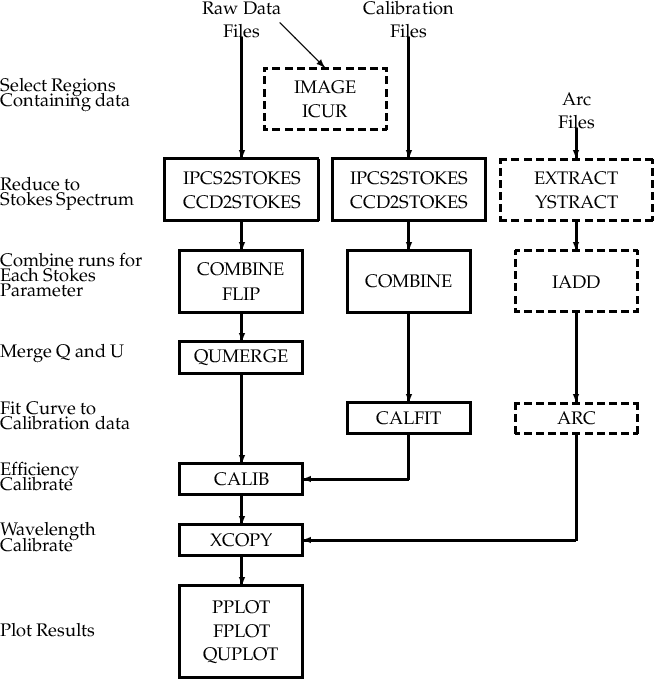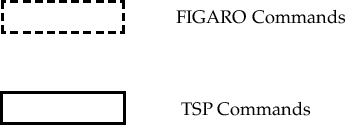

The AAT Pockels cell spectropolarimeter can be used with either CCD or IPCS detectors. However, for use with CCD detectors it is now superseded by the wave-plate polarimeter which is much more efficent. The normal mode of operation is to use a two hole decker above the slit defining star and sky apertures, together with a calcite beam splitter. This gives images containing four spectra, star and sky for each of the O and E modes of the calcite. Images of this type are recorded for the two Pockels cell states (referred to as A and B). In the case of IPCS data a single image contains both Pockels cell states. For CCD data two separate images are taken, one in each state. For a more detailed description of the instrument and its operation see McLean et al. (MNRAS 209, 655, 1984), and the AAO spectropolarimetry manual (AAO UM 24).
A typical observing sequence would consist of observations of the object in two Stokes parameters (Q and U, obtained by inserting different quarter wave plates in the beam), and at two orientations of the instrument usually (90 and 135 degrees). In addition there will be calibration observations of a 100% polarized source (C waveplate position) to calibrate the efficiency of the system, and calibration lamp observations for wavelength calibration. Flux standards may also be observed if flux calibration is required.
To reduce such a data set requires a combination of Figaro and TSP commands. Figaro is used for the standard spectroscopy parts of the reduction such as arc fitting, and reducing flux standards. TSP is used for the polarimetric parts of the reduction. The basic sequence of reductions is shown in figure 1.
The first step in the reduction is to identify the regions of the image containing the four spectra. Having done this the commands IPCS2STOKES or CCD2STOKES can be used to reduce the raw images to TSP format Stokes spectra. Different observations can then be combined. Note that rotating the instrument through 45 degrees effectively interchanges Q and U. Thus to obtain true Q and U the observations must be combined as follows:
| Q=Q90+U135 | (6) |
| U=Q135−U90 | (7) |
Thus when running IPCS2STOKES or CCD2STOKES the Stokes parameter should be specified as Q for a U135 observation and U for a Q135 observation. The sign of the U90 observation can be inverted with the FLIP command. The COMBINE command can be used to combine different observations in the same stokes parameter.
The Stokes parameter data can be plotted using the SPLOT command to check the progress of the reduction, and the consistency of different observations, before combining them.
The Q and U observations can be combined into a single file with the QUMERGE command.
It may be found necessary to FLIP the signs of both Stokes parameters to obtain correct position angles (e.g. If the E and O spectra were not correctly identified). It is useful to have observations of polarized standard stars to check the position angle calibration.
The efficiency of the polarimetry system is not 100%, and varies with wavelength, particularly if a large wavelength range is being observed. Calibration observations with a 100% polarizer inserted can be used to calibrate this effect. Such observations are reduced using the CCD2STOKES or IPCS2STOKES commands, and then a Chebyshev polynomial is fitted to the data using the CALFIT command. This calibration curve can then be used to correct other data using the CALIB command.
Calibration lamp observations can be fitted using the Figaro ARC program, as described in the Figaro manual. The resulting wavelength calibration can then be copied to a TSP file using the TSP command XCOPY, which is similar to the Figaro command of the same name. If desired the TSP data can then be scrunched (rebinned to a linear wavelength scale) using the TSP SCRUNCH command.
Observations of standard stars can be used to derive a flux calibration curve using the methods described in the Figaro documentation. This calibration curve can then be applied to a TSP polarization spectrum to give a flux calibrated polarization spectrum. Note that TSP does not keep track of the total exposure time as spectra are combined, so the total value must be supplied as a parameter to SPFLUX.
There are a number of commands to plot polarization spectra. SPLOT plots a single Stokes parameter, as percentage polarization, together with the intensity spectrum. PPLOT plots percentage polarization, position angle, and intensity. Both these programs use a variable binning technique, to give a constant polarization error per bin.
FPLOT plots data in the form of polarized intensity (or flux). QUPLOT plots a QU diagram.